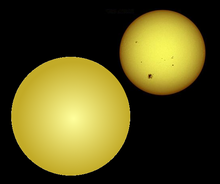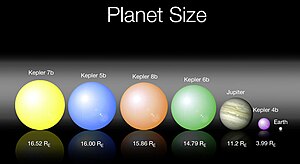Kepler-6
| Observation data Epoch J2000 Equinox J2000 | |
|---|---|
| Constellation | Cygnus |
| Right ascension | 19h 47m 20.9380s[1] |
| Declination | +48° 14′ 23.759″[1] |
| Apparent magnitude (V) | 13.8 |
| Characteristics | |
| Apparent magnitude (J) | 12.001±0.021[2] |
| Apparent magnitude (H) | 11.706±0.019[2] |
| Apparent magnitude (K) | 11.634±0.019[2] |
| Astrometry | |
| Proper motion ( | RA: 0.935(11) mas/yr[1] Dec.: 8.458(12) mas/yr[1] |
| Parallax ( | 1.7108 ± 0.0102 mas[1] |
| Distance | 1,910 ± 10 ly (585 ± 3 pc) |
| Details | |
| Mass | 1.209 M☉ |
| Radius | 1.391 R☉ |
| Temperature | 5647 K |
| Age | 3.8 Gyr |
| Other designations | |
| Database references | |
| SIMBAD | data |
| KIC | data |
Kepler-6 is a G-type star situated in the constellation Cygnus. The star lies within the field of view of the Kepler Mission, which discovered it as part of a NASA-led mission to discover Earth-like planets. The star, which is slightly larger, more metal-rich, slightly cooler, and more massive than the Sun, is orbited by at least one extrasolar planet, a Jupiter-sized planet named Kepler-6b that orbits closely to its star.

Nomenclature and history
[edit]Kepler-6 was named for the Kepler Mission, a NASA project launched in 2009 that aims to discover Earth-like planets that transit, or cross in front of, their home stars with respect to Earth.[4] Unlike stars like the Sun or Sirius, Kepler-6 does not have a common and colloquial name. The discovery of Kepler-6b was announced by the Kepler team on January 4, 2010[5] at the 215th meeting of the American Astronomical Society along with planets around Kepler-4, Kepler-5, Kepler-7, and Kepler-8.[6] It was the third planet to be discovered by the Kepler spacecraft; the first three planets to be verified by data from Kepler had been previously discovered. These three planets were used to test the accuracy of Kepler's measurements.[7]
The discovery of Kepler-6 was confirmed by follow-up observations made using the Hobby–Eberly and Smith telescopes in Texas; the Keck 1 telescope in Hawaii; the Hale and Shane telescopes in southern California; the WIYN, MMT, and Tillinghast telescopes in Arizona; and the Nordic Optical Telescope in the Canary Islands.[8]
Characteristics
[edit]Kepler-6 is a star that is approximately 1.209 Msun, or some five-fourths the mass of the Sun. It is also wider than the sun, with a radius of 1.391 Rsun, or seven-fifths of that of the Sun. The star is approximately 3.8 billion years old, and has an effective temperature of 5647 K (9,705 °F).[9] In comparison, the Sun has a slightly warmer temperature of 5778 K.[10] Kepler-6 has a metallicity of [Fe/H] = +0.34, making it 2.2 times more metallic than the Sun.[7] On average, metal-rich stars tend to be more likely to have planets and planetary systems.[11]
The star, as seen from Earth, has an apparent magnitude of 13.8.[7] It is not visible with the naked eye. In comparison, Pluto's apparent magnitude at its brightest is slightly brighter, at 13.65.[12]
Planetary system
[edit]
Kepler-6 has one confirmed extrasolar planet; it is a gas giant named Kepler-6b.[13] The planet is approximately .669 MJ, or some two-thirds the mass of planet Jupiter. It is also slightly more diffuse than Jupiter, with a radius of approximately 1.323 RJ. Kepler-6b orbits at an average distance of .0456
| Companion (in order from star) |
Mass | Semimajor axis ( |
Orbital period (days) |
Eccentricity | Inclination | Radius |
|---|---|---|---|---|---|---|
| b | 0.669 MJ | 0.04567 | 3.2347 | 0 | — | 1.323 RJ |
See also
[edit]References
[edit]- ^ a b c d Vallenari, A.; et al. (Gaia collaboration) (2023). "Gaia Data Release 3. Summary of the content and survey properties". Astronomy and Astrophysics. 674: A1. arXiv:2208.00211. Bibcode:2023A&A...674A...1G. doi:10.1051/0004-6361/202243940. S2CID 244398875. Gaia DR3 record for this source at VizieR.
- ^ a b c Skrutskie, Michael F.; Cutri, Roc M.; Stiening, Rae; Weinberg, Martin D.; Schneider, Stephen E.; Carpenter, John M.; Beichman, Charles A.; Capps, Richard W.; Chester, Thomas; Elias, Jonathan H.; Huchra, John P.; Liebert, James W.; Lonsdale, Carol J.; Monet, David G.; Price, Stephan; Seitzer, Patrick; Jarrett, Thomas H.; Kirkpatrick, J. Davy; Gizis, John E.; Howard, Elizabeth V.; Evans, Tracey E.; Fowler, John W.; Fullmer, Linda; Hurt, Robert L.; Light, Robert M.; Kopan, Eugene L.; Marsh, Kenneth A.; McCallon, Howard L.; Tam, Robert; Van Dyk, Schuyler D.; Wheelock, Sherry L. (1 February 2006). "The Two Micron All Sky Survey (2MASS)". The Astronomical Journal. 131 (2): 1163–1183. Bibcode:2006AJ....131.1163S. doi:10.1086/498708. ISSN 0004-6256. S2CID 18913331. Vizier catalog entry
- ^ "Kepler-6". SIMBAD. Centre de données astronomiques de Strasbourg. Retrieved 2019-11-29.
- ^ "Mission overview". Kepler and K2. NASA. 13 April 2015. Retrieved 7 August 2020.
- ^ Alexander J. Willman Jr. (5 January 2010). "Kepler 6 Planetary System". Princeton University. Retrieved 19 February 2011.
- ^ Rich Talcott (5 January 2010). "215th AAS meeting update: Kepler discoveries the talk of the town". Astronomy.com. Astronomy magazine. Retrieved 19 February 2011.
- ^ a b c d "Summary Table of Kepler Discoveries". NASA. 2010-08-27. Archived from the original on 2010-05-27. Retrieved 2010-10-16.
- ^ "NASA's Kepler Space Telescope Discovers its First Five Exoplanets". NASA. 4 January 2010. Archived from the original on 4 April 2012. Retrieved 26 February 2011.
- ^ a b "Notes for star Kepler-6". Extrasolar Planets Encyclopaedia. 2010. Archived from the original on 21 January 2011. Retrieved 19 February 2011.
- ^ Fraser Cain (September 15, 2008). "Temperature of the Sun". Universe Today. Retrieved 19 February 2011.
- ^ Charles H. Lineweaver (2001). "An Estimate of the Age Distribution of Terrestrial Planets in the Universe: Quantifying Metallicity as a Selection Effect". Icarus. 151 (2): 307–313. arXiv:astro-ph/0012399. Bibcode:2001Icar..151..307L. doi:10.1006/icar.2001.6607. S2CID 14077895.
- ^ "Pluto Fact Sheet". Goddard Space Flight Center. NASA. 17 November 2010. Retrieved 24 February 2011.
- ^ Dunham, Edward W.; et al. (2010). "Kepler-6b: A Transiting Hot Jupiter Orbiting a Metal-rich Star". The Astrophysical Journal Letters. 713 (2): L136–L139. arXiv:1001.0333. Bibcode:2010ApJ...713L.136D. doi:10.1088/2041-8205/713/2/L136.
